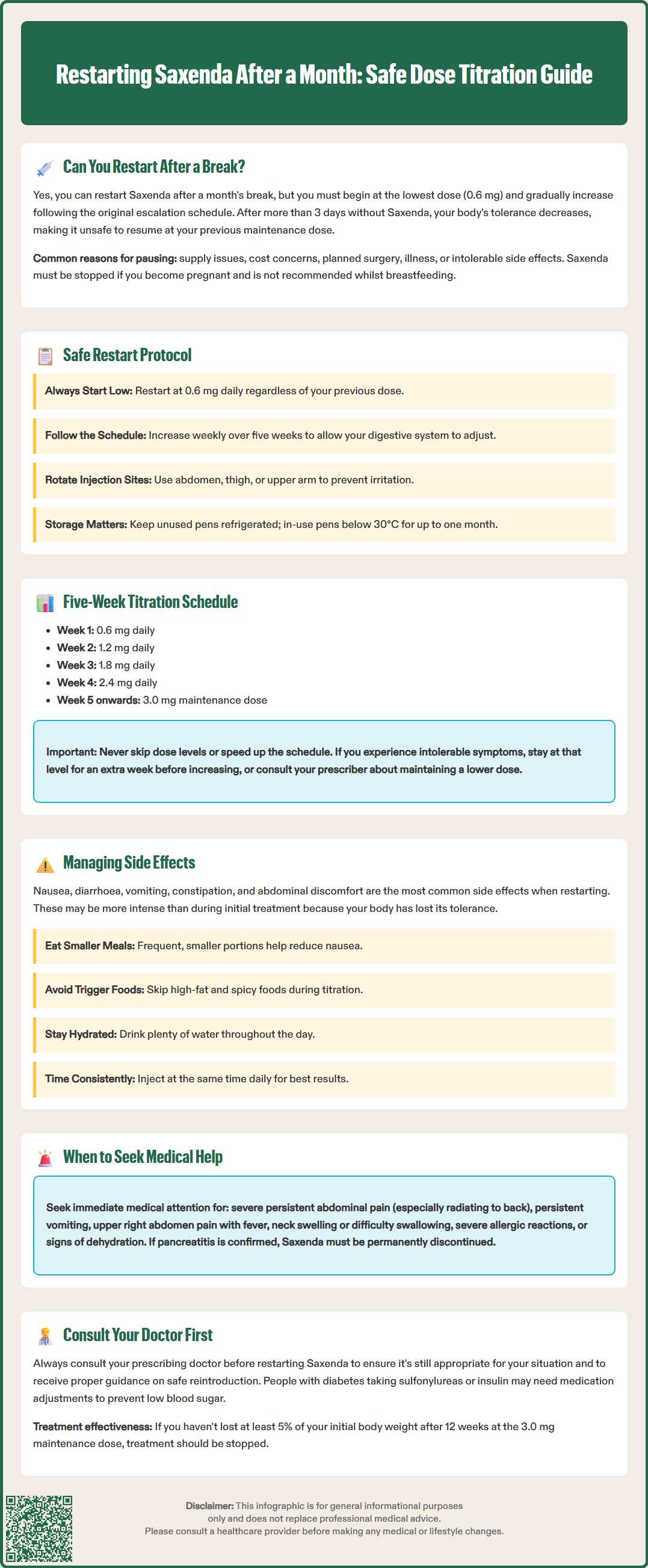LOSE WEIGHT WITH MEDICAL SUPPORT — BUILT FOR MEN
- Your personalised programme is built around medical care, not willpower.
- No generic diets. No guesswork.
- Just science-backed results and expert support.
Find out if you’re eligible

Restarting Saxenda (liraglutide 3.0 mg) after a month's break requires careful medical supervision and adherence to dose escalation protocols. Saxenda is a glucagon-like peptide-1 (GLP-1) receptor agonist licensed in the UK for weight management in adults with obesity or overweight with comorbidities. If more than three days have elapsed since your last dose, you must restart at the lowest dose of 0.6 mg and follow the five-week titration schedule to minimise gastrointestinal side effects and ensure safe, effective treatment. This article explains how to safely restart Saxenda, what to expect, and when to seek medical advice.
Quick Answer: You can restart Saxenda after a month's break, but you must begin at 0.6 mg and follow the five-week dose escalation schedule under medical supervision.
Yes, you can restart Saxenda (liraglutide 3.0 mg) after a month's break, but it is essential to approach this carefully and under medical supervision. Saxenda is a glucagon-like peptide-1 (GLP-1) receptor agonist licensed in the UK for weight management in adults with a body mass index (BMI) of 30 kg/m² or greater, or 27 kg/m² or greater with weight-related comorbidities such as type 2 diabetes or hypertension.
According to the Saxenda Summary of Product Characteristics (SmPC), if more than 3 days have elapsed since your last dose, you should restart at 0.6 mg and follow the dose escalation schedule. When treatment is interrupted, the medication's effects on your body diminish, and your tolerance to the drug may decrease. This means that restarting at your previous maintenance dose could significantly increase the risk of gastrointestinal side effects, particularly nausea, vomiting, and diarrhoea.
There are various reasons why patients may need to pause Saxenda treatment, including:
Supply issues or cost considerations
Planned surgery or medical procedures
Intercurrent illness
Intolerable side effects requiring a treatment break
It's important to note that Saxenda should be discontinued if pregnancy occurs and is not recommended during breastfeeding. Additionally, Saxenda should not be used concurrently with other GLP-1 receptor agonists.
Before restarting Saxenda, contact your prescribing clinician to discuss your individual circumstances. They will assess whether Saxenda remains appropriate for you, review any changes in your medical history, and provide guidance on the safest reintroduction schedule. In the UK, Saxenda is typically prescribed through specialist weight management services in accordance with NICE Technology Appraisal (TA664) criteria. Do not restart the medication without medical advice, as improper reinitiation may compromise both safety and treatment efficacy.
Restarting Saxenda safely requires a structured approach that mirrors the initial titration schedule. You should not resume at your previous maintenance dose after a break. Instead, treatment must be reintroduced gradually, beginning at the lowest dose of 0.6 mg once daily, administered subcutaneously at any time of day, with or without meals.
The standard dose escalation protocol involves:
Week 1: 0.6 mg once daily
Week 2: 1.2 mg once daily
Week 3: 1.8 mg once daily
Week 4: 2.4 mg once daily
Week 5 onwards: 3.0 mg once daily (maintenance dose)
This gradual titration allows your gastrointestinal system to adapt to the medication's effects, significantly reducing the likelihood of troublesome side effects. Each dose increase should only occur after at least one week at the current dose, and you should not progress to the next dose level if you are experiencing intolerable symptoms.
If you miss a dose:
If the next scheduled dose is more than 12 hours away, take the missed dose as soon as you remember
If the next scheduled dose is due within 12 hours, skip the missed dose and take your next dose as usual
Do not take an extra dose or increase the dose to make up for a missed dose
Practical administration tips when restarting include:
Inject into the abdomen, thigh, or upper arm, rotating injection sites to prevent lipohypertrophy
Store unused pens in the refrigerator (2–8°C); do not freeze; once in use, they can be kept at room temperature (below 30°C) for up to one month
Keep the pen cap on when not in use to protect from light
Set a daily reminder to maintain consistency, as this improves both efficacy and tolerability
Keep a symptom diary during the first few weeks to monitor side effects
Contact your GP or prescriber immediately if you experience severe abdominal pain, persistent vomiting, or signs of pancreatitis (severe upper abdominal pain radiating to the back). If pancreatitis is suspected, Saxenda should be discontinued immediately and not restarted if pancreatitis is confirmed.

Gastrointestinal side effects are the most common adverse reactions when restarting Saxenda, particularly if dose escalation is not followed appropriately. These effects occur because liraglutide slows gastric emptying and affects gut motility, mechanisms that contribute to both its weight loss efficacy and its side effect profile.
The most frequently reported side effects include:
Nausea (very common, affecting more than 1 in 10 people) – typically most pronounced during dose escalation and often improves with continued use
Diarrhoea (very common) – may be accompanied by abdominal discomfort
Constipation (common, affecting up to 1 in 10 people)
Vomiting (very common) – more likely if doses are increased too rapidly
Dyspepsia and gastro-oesophageal reflux
Abdominal pain or distension
Headache, dizziness and fatigue (very common)
Injection site reactions (redness, swelling or irritation)
These symptoms are generally mild to moderate and transient, resolving within days to weeks as your body readjusts to the medication. However, when restarting after a break, you may experience these effects more intensely than during your initial treatment course, as your tolerance has diminished.
Strategies to minimise side effects include:
Eating smaller, more frequent meals rather than large portions
Avoiding high-fat, spicy, or rich foods that may exacerbate nausea
Staying well hydrated, particularly if experiencing diarrhoea or vomiting
Taking the injection at a consistent time when side effects are least disruptive to your daily routine
For people with diabetes who are also taking sulfonylureas or insulin, there is an increased risk of hypoglycaemia. Your prescriber may need to adjust these medications when restarting Saxenda.
Seek medical advice if you experience:
Severe, persistent abdominal pain (possible pancreatitis)
Signs of gallbladder disease (pain in the upper right abdomen, fever, jaundice)
Persistent neck swelling, hoarseness, or difficulty swallowing (thyroid-related concerns)
Severe allergic reactions (rash, swelling, difficulty breathing)
Persistent or severe palpitations, especially if associated with dizziness or fainting
Signs of dehydration (excessive thirst, dark urine, dizziness) or inability to keep fluids down
If side effects are intolerable despite following the titration schedule, discuss with your prescriber whether to slow the dose escalation or consider alternative weight management strategies.
Report any suspected adverse reactions to the MHRA Yellow Card Scheme (yellowcard.mhra.gov.uk).
The dose titration schedule for restarting Saxenda is identical to the initial treatment protocol, regardless of what dose you were taking before your break. According to the Saxenda SmPC, if more than 3 days have elapsed since your last dose, you should restart at 0.6 mg and follow the dose escalation schedule. This standardised approach is based on clinical trial data and post-marketing surveillance, which demonstrate that gradual dose escalation optimises both tolerability and treatment adherence.
Standard five-week titration schedule:
Week 1: 0.6 mg daily
Begin with the lowest dose to reintroduce your body to liraglutide's effects. At this dose, you may notice mild appetite suppression, but significant weight loss is not expected. Monitor for any gastrointestinal symptoms and ensure you are comfortable with the injection technique.
Week 2: 1.2 mg daily
Double the dose after completing seven days at 0.6 mg. You may begin to notice more pronounced effects on appetite and satiety. Mild nausea is common at this stage but should not be severe.
Week 3: 1.8 mg daily
Continue the escalation if the previous dose was well tolerated. Gastrointestinal effects may peak during this week but typically improve with continued use.
Week 4: 2.4 mg daily
Approach the near-maintenance dose. By this stage, most patients have adapted to the medication's effects, and side effects should be diminishing.
Week 5 onwards: 3.0 mg daily (maintenance dose)
Reach the therapeutic dose for weight management. This is the dose used in clinical trials demonstrating efficacy for weight loss.
Important considerations:
Do not skip dose levels or accelerate the schedule, as this significantly increases side effect risk
If you experience intolerable symptoms at any dose, remain at the current dose for an additional week before attempting to increase
If symptoms persist, contact your prescriber to discuss whether to continue escalation or maintain a lower dose
According to the Saxenda SmPC and NICE TA664, treatment should be discontinued if patients have not lost at least 5% of their initial body weight after 12 weeks at the maintenance dose
In the NHS, Saxenda treatment is typically limited to a defined duration (up to 2 years) in specialist weight management services as per NICE TA664
Your prescriber may modify this schedule based on your individual circumstances, previous tolerance, or concurrent medications. Always follow the specific advice provided by your healthcare professional rather than self-adjusting doses.
Yes, if more than 3 days have elapsed since your last dose, you must restart at 0.6 mg and follow the five-week dose escalation schedule to minimise side effects and ensure safety.
The most common side effects are nausea, diarrhoea, vomiting, and abdominal discomfort, which typically occur during dose escalation and improve within days to weeks as your body readjusts to the medication.
Yes, you should contact your prescribing clinician before restarting Saxenda to review your medical history, assess whether treatment remains appropriate, and receive guidance on safe reintroduction.
All medical content on this blog is created based on reputable, evidence-based sources and reviewed regularly for accuracy and relevance. While we strive to keep content up to date with the latest research and clinical guidelines, it is intended for general informational purposes only.
DisclaimerThis content is not a substitute for professional medical advice, diagnosis, or treatment. Always consult a qualified healthcare professional with any medical questions or concerns. Use of the information is at your own risk, and we are not responsible for any consequences resulting from its use.